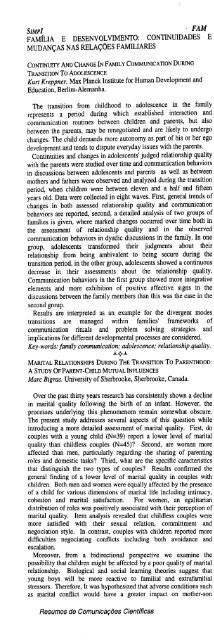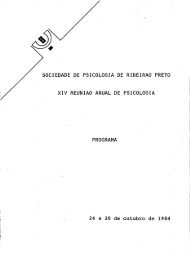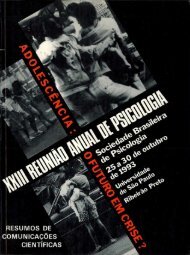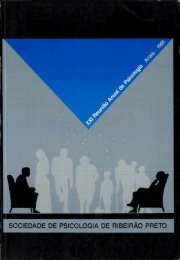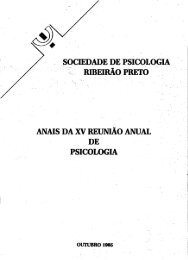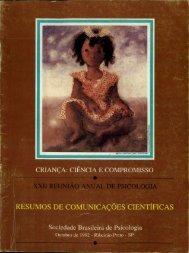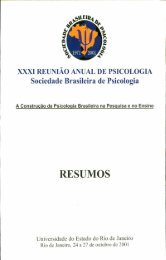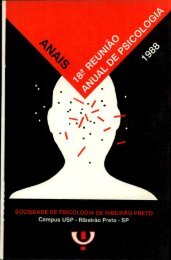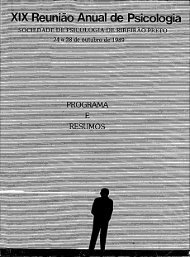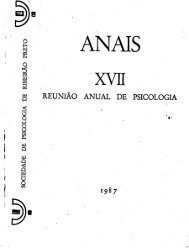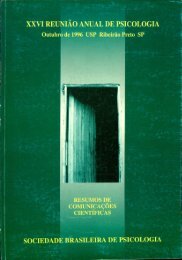1999 - Sociedade Brasileira de Psicologia
1999 - Sociedade Brasileira de Psicologia
1999 - Sociedade Brasileira de Psicologia
Create successful ePaper yourself
Turn your PDF publications into a flip-book with our unique Google optimized e-Paper software.
&M#1<br />
'FàM<br />
FAMfLIA E DESENVOF IMENTO: CONTINUIDADES E<br />
MUDANCASNASRELK OESFAMILIARES<br />
CONTINUITY ANDCHANGEIN FAMILY COMMUMCATION DURING<br />
TRANSITION TO ADOLESCENCE<br />
KurtKreppner.MaxPlanck InstituteforHumanDevelopmentand<br />
Education,Berlim-Memanha.<br />
n e transition from childhood to adolescence in the family<br />
represents a period during which established interaction and<br />
communication routines between children and parents,but also<br />
Letween the parents,may be renegotiated and are likely to un<strong>de</strong>rgo<br />
changes.Thechild <strong>de</strong>mandsmore autonomy aspartofhisorhereg0<br />
<strong>de</strong>velopmentandtendstodisputeeverydayissueswith theparents.<br />
Continuitiesandchangesinadolescents'judgedrelationshipquality<br />
with the parentswere sttldied overtime and communication behaviors<br />
in discussiûnsbetween adolescentsand parents aswellasbetween<br />
mothersandfatherswereobservedand analyzedduring theeansition<br />
period,when children werebetween elevenanda halfand tifteen<br />
yearsold.Data werecolected in eightwaves.First,generaltrendsof<br />
changes in both assessed relationship quality and communication<br />
behaviorsare reported,second,a<strong>de</strong>tailed analysisof two groupsof<br />
families isgiven,where marked changesoccurred overtime both in<br />
the assessment of relationship quality and in the observed<br />
communication behaviorsin dyadic discussionsin the family.In nne<br />
group, adolescents transfonned their judgments about their<br />
relationship from being ambivalent to being secure during the<br />
transitionperiodvintheothergroup,adolescentsshowed acontinuous<br />
<strong>de</strong>crease in their assessments about the relationship quality.<br />
Communication behaviorsin the tirstgroup showed more integrative<br />
elements and more exhibition of positive afective signsin the<br />
discussionsbetween the family membersthan thiswasthe casein the<br />
second group.<br />
Resultsare inteqveted asan example forthe divergentmo<strong>de</strong>s<br />
transitions are managed within families' frateworks of<br />
communication rimals and problem solving strategies and<br />
implicationsfordiffcrent<strong>de</strong>vclopmentalprocessesareconsi<strong>de</strong>red.<br />
Key-wordslfamilycommunication;adolescence;relationship guulfly.<br />
A+A<br />
MARITAL RELATIONSHPSDURWG 'IXE W ANSITION TO PARENTHOOD:<br />
A STUDYOFPARENT-CHI,D MUTUALINFLUENCES<br />
MarcBigras.University of Sherbrooke,Sherbrnoke,Canada.<br />
Overthe pastthirty yearsresearch hasconsistently shown a<strong>de</strong>cline<br />
in marital quality following the birth ofan infant.However,the<br />
processes un<strong>de</strong>rlying thisphenomenom remain somewhatobscure.<br />
n e presentstudy addresses severalaspectsofthis question while<br />
introducing amore <strong>de</strong>tailed assessmentofmaritalquality.First,do<br />
coupleswith ayoung child (N=39)reportalowerlevelofmarital<br />
quality than childlesscouples(N-4<br />
5)? Second,arewomen more<br />
affected than men,particularly regarding the sharing ofparenting<br />
rolesand domestictasks? n ird,whatare the specilic caracteristics<br />
thatdistinguish the two types ofcouples? Resultscontirmed the<br />
generalfinding ofa lowerIevelofmaritalquality in coupleswith<br />
children.Both men and women were equally affected by the presence<br />
of achild forvmiousdimensionsofmaritallife including intimacy,<br />
cohesion and marital satisfaction. For women, an egalitarian<br />
distribution ofroleswaspositively associated with theirperception of<br />
maritalquality. Item analysis revealed thatchildless coupleswere<br />
more satisfied with their sexual relation, commitment and<br />
negociation style. In contrast,couples with children reporte,d more<br />
difficulties negociating conflicts including both avoidance and<br />
escalation.<br />
M oreover, from a bidirectional perspective we examine the<br />
possibility thatchildren mightbeaffected by a poorquality ofmarital<br />
relationship. Biological and sociallearning theories suggestthat<br />
young boys will be more reactive to familial and extrafamilial<br />
stressors.n erefore,Itwashypothesized thatadverseconditionssuch<br />
as marital contlict would have a greater impact on mother-son<br />
Resvmos<strong>de</strong>ComvnicaçöesCientl-ficas<br />
interactionsas cnmpared to mother-daugtherinteractions.Ninetp<br />
seven mother-childpairswereobserved in alaboratorysettinginthe<br />
presenceon anotherunfamiliarmcther-child pair.Resultsindicated<br />
thateconomic,maritaland parentalstressaccounted f0rup toeight<br />
timesmore variance in mother-son interaction ascûmpared to motherdaughter.Mothers<br />
wh0 reported more social isolation, a more<br />
coercive maritalrelationship,and greaterstressin the parentalrole,<br />
weremoredistant,col<strong>de</strong>r,and lessattentive in theirinteractionswith<br />
theirpreschoolsons. n ese results are interpreted in termsofa<br />
bidirectionalmo<strong>de</strong>l in which matem al,child and family ecology<br />
ccntributionsare consi<strong>de</strong>red. .<br />
In or<strong>de</strong>rto give complementary informations,we also presenta<br />
longitudinalstudy examined the impactofthe quality ofmalital<br />
relationship on thequalityofgarenting in adolescentmothers.98<br />
pregnant(6months)adolescents,recruited inas?ecialschooland<br />
severalYouthCentrersin Montreal,tiledquestiolmairesabouttheir<br />
personalhistory (atachment,abusive parenting) and cognitive<br />
feadines for parenting (CRP),thatis specific atitu<strong>de</strong>s and<br />
kcowledge about childrearing, 9 mlmths later, mothers were<br />
vi<strong>de</strong>otaped in alaboratory session and were asked to tilltheDyadic<br />
AdjustmentScale(DAS,Spanier,1976).Theresultssuggestedthat<br />
male partners seem to play a mediating role on the effective<br />
expression ofadolescentmothcrs'parentalreadiness.<br />
Key-words:parenthoodifamilytransition;maritalrelationships.<br />
A@A<br />
MUDANCASDEVALORESDEUMA GERACAO PARA OUTRA NOBRASL<br />
N lia M.M.Biasoli-élves.Universida<strong>de</strong><strong>de</strong>SâoPaulo,RibeirLoPreto<br />
A pesquisa da vida familiarcresceu em importbciadurante as<br />
tiltimasdécadas,buscando,sobretudo,respon<strong>de</strong>rquestöesteöricase<br />
prsticas.Taispesquisastêm evi<strong>de</strong>nciado quenassocieda<strong>de</strong>surbanas<br />
oci<strong>de</strong>ntais,()perfodo<strong>de</strong>nominado<strong>de</strong>infânciaestsnum processo<strong>de</strong><br />
constantealteraçâo.Estetrabalhoobjetivamostraramaneiracomo<br />
evoluem as relaçöes entre adultos e crianças <strong>de</strong>ntro do nlicleo<br />
familiarsaolongo<strong>de</strong>steséculo,tomandoporbaseum conjunto<strong>de</strong><br />
estudosquevêm sendorealizadosnoProjetolntegrado'Taml'liae<br />
Socializaçb :Processos,Mo<strong>de</strong>los e Momentosno Contato entre<br />
Geraçöes''.Dados<strong>de</strong> 45 entrevistasscmi-estruturadas,realizadascom<br />
pessoas <strong>de</strong> ida<strong>de</strong> variando entre 90 e 22 anosforam analisados,<br />
focalizando-se asrotinasdisrias,asrelaçöesadulto-criança,ativida<strong>de</strong>s<br />
escolares,brinquedo/brinca<strong>de</strong>ira,valoreséticose prâticasrcligiosas.<br />
Paralelamente,foram consi<strong>de</strong>radostambém osresultadosgerais<strong>de</strong><br />
questitmMosaplicadosa360jovens,alunosda1'.sériedo2@.grau,<br />
entre 15 e 16 anos<strong>de</strong> ida<strong>de</strong>,pertencentesàscamadasmédias.A<br />
comparaçâo entre geraçöes mostra: 1) um aumento no nfvel<br />
educacional<strong>de</strong> homense mulheres,'associado a uma escolarizaçâo<br />
precocedascrianças,atualmente;2)asubstituiçiodaautorida<strong>de</strong>dos<br />
adultos por uma rclaçâo mais amigJvel entre pais e filhos,<br />
predominando,hoje,aliberda<strong>de</strong><strong>de</strong>expresào;3)uma mudança<br />
acentuada nasativida<strong>de</strong>s <strong>de</strong> brinquedo/brinca<strong>de</strong>ira com diminuiçâo<br />
substancialdo espaço,masaumento na qualida<strong>de</strong> e sotisticaçâodos<br />
brinquedos,resguardadasasespeciticida<strong>de</strong>s<strong>de</strong>cadageraçso;4)a<br />
substituiçâo, mais recente, da puniçâo ffsica, caracterfstica das<br />
primeirasgtraçöes,porformasverbaise expectativas<strong>de</strong> correfâo do<br />
comportamento infantil;5)a abertura para discussâo <strong>de</strong> questöes<br />
referentes àsexualida<strong>de</strong>;6)aTV como uma influência na vida<br />
familiar,que se acentua a partir dos anos cinquenta;7) uma<br />
diminuiçâo na participaçâo,pela fanuelia,em ativida<strong>de</strong>s<strong>de</strong> cunho<br />
religioso,especialmenteligadasàreligiâocatölica)8)aalteraçâo.da<br />
prlticaparao discurso.<strong>de</strong> valorestaiscomo selieda<strong>de</strong> no trabalho,<br />
responsabilida<strong>de</strong> <strong>de</strong> uns para com os outros <strong>de</strong>ntro das fnmqias,<br />
caracterizando a acentuaçâo da individualida<strong>de</strong> na vida da fanu-lia<br />
urbana mo<strong>de</strong>rna.Discute-se aperspectiva que se <strong>de</strong>lineia quanto a<br />
valores,préticas<strong>de</strong>cuidado e educaçâo,formas<strong>de</strong>relacionamento e<br />
<strong>de</strong>senvolvimento social e emocional da crimwa nesse tipo <strong>de</strong><br />
socieda<strong>de</strong>essencialmenteurbana,fundada em padröcs<strong>de</strong>consumo<br />
intenso,aliado a um sistemaeconômico gerador<strong>de</strong> dificulda<strong>de</strong>spara<br />
a convivência familiar.<br />
Palavras-chave: rnu/aafw.çfamiliares, relaçses adulto-criança e<br />
relaçöesentre gdm çtsel. <<br />
9


